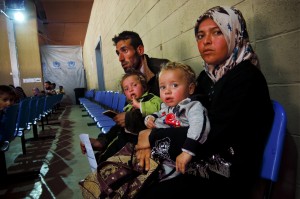 The number of Syrian refugees in Lebanon has now reached an estimate of 450,000, and the inflow surpasses the capacity of the country by all means. Danish Refugee Council is working with local municipalities to identify additional shelter areas – and in arranging distributions of items such as mattresses and blankets for the newly arrived.
The number of Syrian refugees in Lebanon has now reached an estimate of 450,000, and the inflow surpasses the capacity of the country by all means. Danish Refugee Council is working with local municipalities to identify additional shelter areas – and in arranging distributions of items such as mattresses and blankets for the newly arrived.
Recently some of the largest inflows of Syrian refugees have been seen in the northern part of Lebanon. In for instance Wadi Khaled, shelters and houses have reached their capacities, and with a larger influx of refugees expected in the coming weeks and months, it is getting harder and harder for the communities to cope with the high number of refugees. Even though many are living with relatives, and the Lebanese have been generous in welcoming the refugees, the increasing number in some of the poorest parts of Lebanon adds an unbearable pressure on the local communities.
“People are living more than 30 individuals in each house, and the current situation will not be sustainable past the first few weeks with these most recent additions. Further assistance, particularly with shelter and WASH is needed,” says Olivier Beucher, country director for DRC in Lebanon – speaking of the situation in Wadi Khaled.
Families from the Qusayr area in Syria are trying to flee, in response to the deteriorating security situation, due to recent intensification of fighting in the areas. And even though it is both very dangerous and expensive, they often see no other solution.
DRC is working with the municipalities to assist new arrivals to Wadi Khaled through a range of distribution, shelter, psychosocial and referral activities – and to identify potential additional shelter areas in the case of additional influx. Last week, DRC and Premiere Urgence conducted a rapid assessment of influx of refugees in Wadi Khaled, North Lebanon, in coordination with UNHCR. The team assessed 1180 individuals on one day, finding an urgent need for additional shelters and distributions.
The number of registered Syrian refugees in Lebanon has more than tripled the last six months. 450,000 Syrian refugees are now in the country, but only 339,000 of those have yet been registered as refugees by UNHCR. Lebanon continues to host the largest population affected by the Syrian crisis, and DRC and its partners are delivering essential services to meet their needs. The DRC was among the first humanitarian organizations to provide assistance in North Lebanon, when the Syrian refugees first started crossing the border in the spring of 2011. Alone in March, 2013 almost 200,000 individuals have been assisted through DRC’s distribution activities in Lebanon.
Reuters
Leave a Reply
You must be logged in to post a comment.